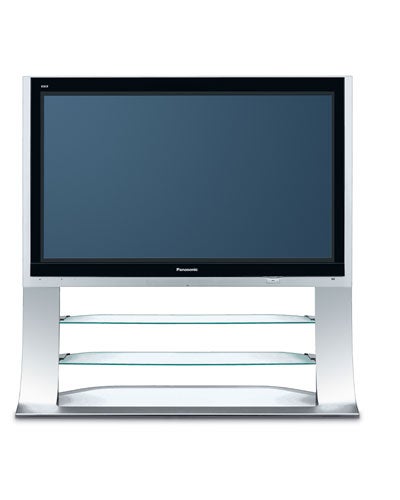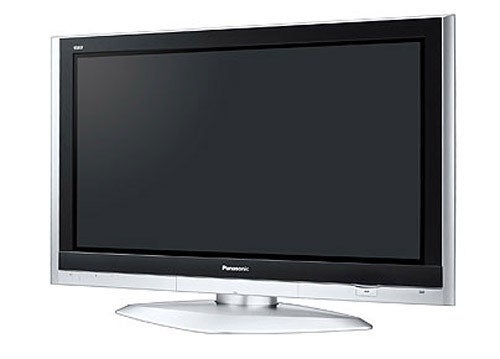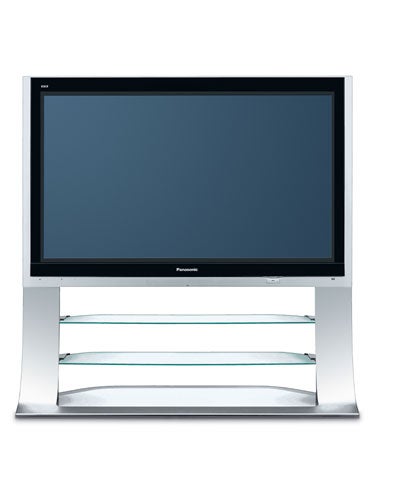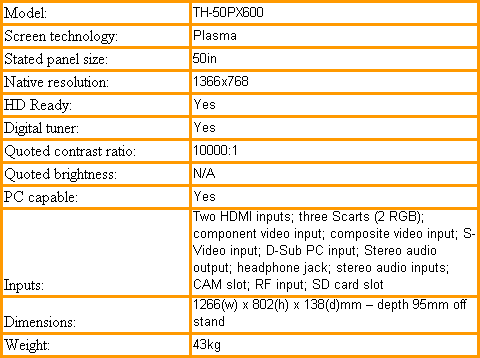Panasonic Viera TH-50PX600 50in plasma Review
Panasonic Viera TH-50PX600 50in plasma
If you can fit a 50in TV in your living room, this is the one you want.

Verdict
Key Specifications
- Review Price: £2500.00
The only problem with the Panasonic 37in TH-37PX600 we looked at a few weeks ago was that there just wasn’t enough of it. Which is why we’re cockahoop – whatever the hell that means – to have our grubby mitts this week on its much bigger sibling, the 50in TH-50PX600. If the picture talents that made the 37in model so special can stretch themselves as far as 50in, we could have something truly special on our hands.
Not that it looks anything particularly special. There’s still just too much plasticky greyness going on for comfort. That said, spend a few extra bob investing in Panny’s floorstanding cabinet option for this TV and the design suddenly sparks into life, as the style emphasis suddenly shifts from the colour scheme to the TV’s impressive slenderness.
Connectivity needs no ‘accessorising’ to win our hearts, though. The first thing that leaps out is the presence of two HDMI inputs, permitting simultaneous connection of, say, an HD-DVD/Blu-ray player and a Sky HD receiver. An impressive three Scarts show that Panny hasn’t forgotten the ‘standard definition’ things in life either, while other highlights include component video jacks; a D-Sub PC interface; a CI slot where you can put conditional access cards for receiving subscription digital TV services; and an SD card slot for direct playback of digital stills.

Actually, deeper investigation reveals that the SD card slot does rather more than that. For it can also play or even record MPEG4 movies, meaning the potential is there for you to record a TV show onto an SD card for later viewing on a portable video device on your way to work! Needless to say, such a nod to our love of all things gadgety is just fine by us.
The HDMIs, too, have an extra string to their bow: HDAVI. This is a new system that enables the 50PX600’s HDMI sockets to enjoy enhanced, two-way ‘system building’ communication with compatible Panasonic devices like its latest range of DIGA digital recorders. In an ideal world HDAVI wouldn’t just work with Panny-branded stuff, allowing you to build your AV system using whatever brand of gear you wanted. But such an egalitarian approach was never really likely to happen when there’s money to be made from tempting people into ‘all-Panasonic’ systems.
As a jumping off point for an assessment of the 50PX600’s other features, let’s go over the things that make the PX600 range Panasonic’s current flagship ahead of the its PX60 models. One we’ve actually already covered; the SD card slot. Another is the provision on the PX600s of full picture in picture facilities. And the last one is a beefed up audio system that replaces the standard speakers of the PX60s with units equipped with twin passive radiator woofers to boost bass output and deliver more clarity and raw power.
Naturally the 50PX600 is HD Ready, with a native resolution of 1,366 x 768, while other specs of interest include a really remarkably high 10000:1 claimed contrast ratio, and a purported 29 billion colour count achieved via some fancy 11.5-bit video processing.
As revealed by the CI slot mentioned earlier, the 50PX600 has a built-in digital tuner. And this is backed up by 7-day electronic programme guide support.

On hand to boost picture quality, meanwhile, is a new Panasonic picture processing engine called V-Real. The main focuses of this are: processing of 720p/1080i sources in their native form; enhanced gamma processing to increase the subtlety of the colour gradation steps; sub-pixel control to make lines sharper by processing individually the red, green and blue elements of each pixel; and circuitry for adding extra detail to standard definition images.
As if all this wasn’t enough, there’s a new Deep Black Filter in the plasma panel to reduce onscreen reflections, new, preventative (as opposed to reactive) noise reduction systems, and a colour management routine that separates video signals’ colour and luminosity components before processing them to improve colour toning.
While this all sounds deeply impressive on paper, though, it still scarcely prepares you for just how stunning the 50PX600’s pictures usually are in practice.
Particularly eye-catching on such a vast screen is how sharp and textured the picture looks while watching high definition. All the effort Panasonic has put into its picture processing results in stunningly fine colour blends, largely noise-free textures and edges, and a general crispness that’s rare on any plasma TV, never mind one this large.
The picture also has bags of cinematic drama, by which we mean that it reaches extraordinary black level depths by flat TV standards while also portraying bright parts of the picture with plenty of vibrancy. This works wonders on games too, with the Willamette Mall in Dead Rising on the Xbox 360 looking particularly fine.
Actually, the black level part of the above equation is arguably the most impressive we’ve seen on a big-screen flat TV – especially as the profound blackness of dark areas isn’t achieved at the expense of the sort of shadow details that make dark scenes believable and ‘three-dimensional’.
Colours, meanwhile, benefit from a superbly expansive palette, meaning you get natural, unforced tones covering more of the colour spectrum than is common in the flat TV world.

Chuck in on top of all these glories superbly clean motion handling and standard definition pictures far more watchable than is usual for a 50in TV, and Panasonic clearly has another plasma winner on its hands.
Things are not completely perfect, mind. Some big LCDs, for instance, look slightly more detailed with HD. Some LCDs can also look slightly more aggressively vibrant – though this usually comes at the price of some less authentic colour tones. And finally, if you watch the 50PX600 from an angle, you occasionally become aware of a ‘ghost’ image offset from the main one, caused by the use – common in the plasma world – of two separate sheets of glass in the screen construction. Even added together, though, the 50PX600’s niggles are punily insignificant versus all the good stuff its pictures have got going on.
There’s plenty of good stuff going on with the TV’s audio too, which presents a bold, punchy soundstage that delivers ample bass and treble extremes wrapped around an open, natural mid-range.
”’Verdict”’
This is quite simply the finest 50in TV we’ve seen to date. Need we say more?

How we test televisions
We test every TV we review thoroughly over an extended period of time. We use industry standard tests to compare features properly. We’ll always tell you what we find. We never, ever, accept money to review a product.
Trusted Score
Score in detail
-
Value 9
-
Image Quality 9
-
Sound Quality 9

